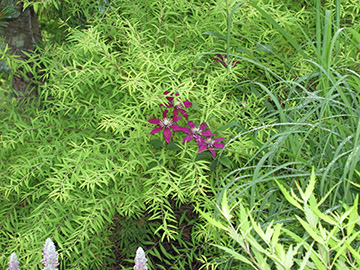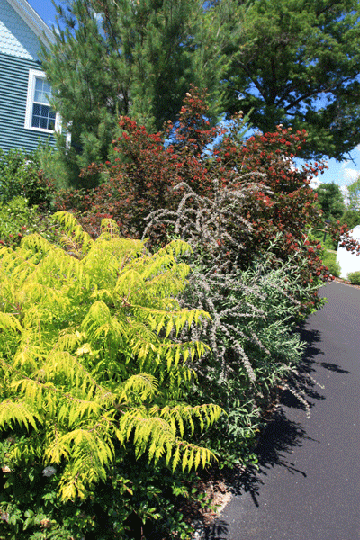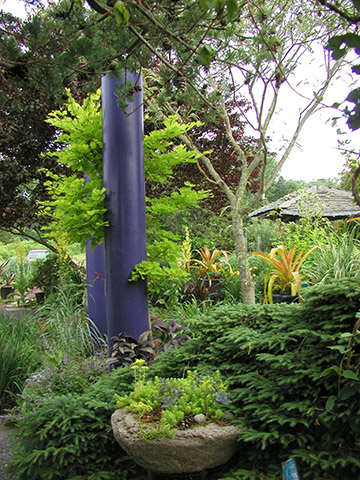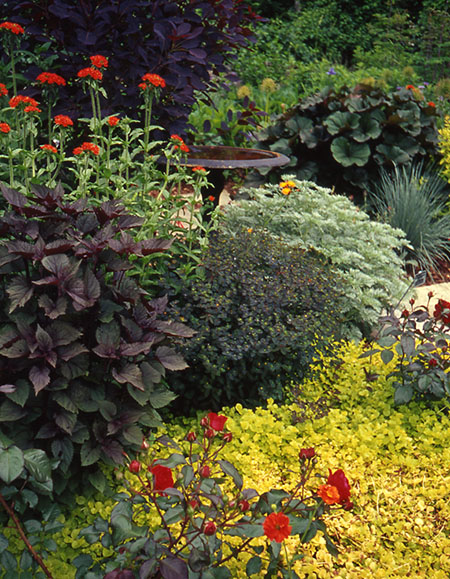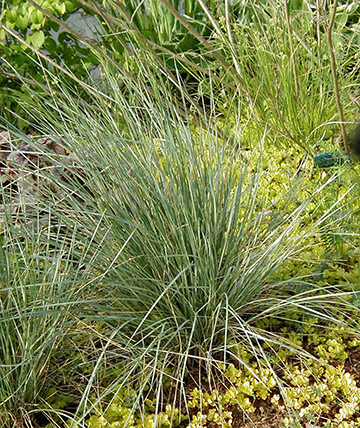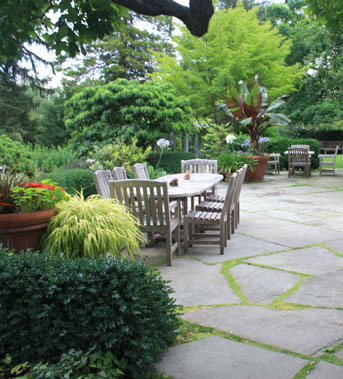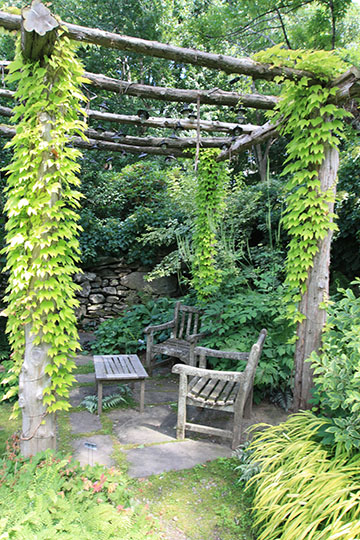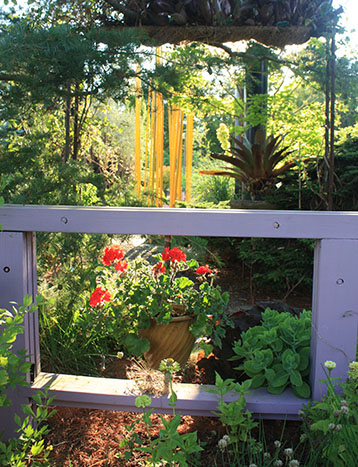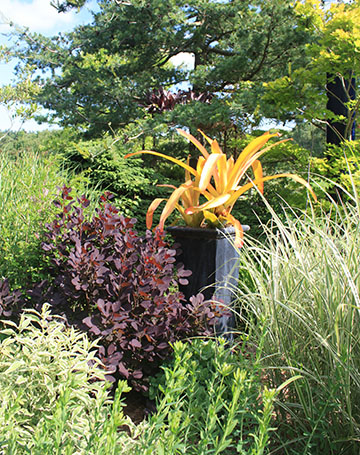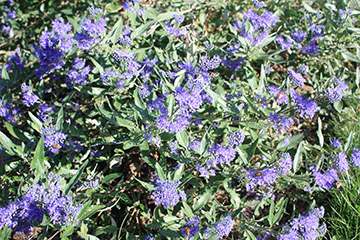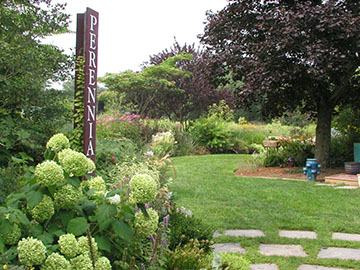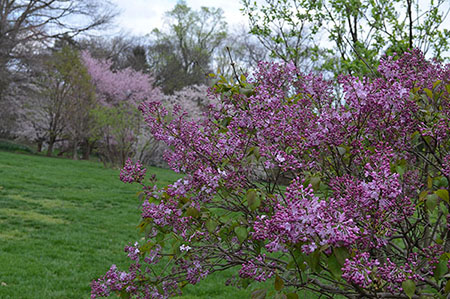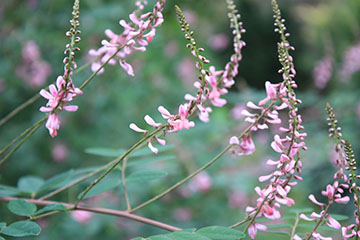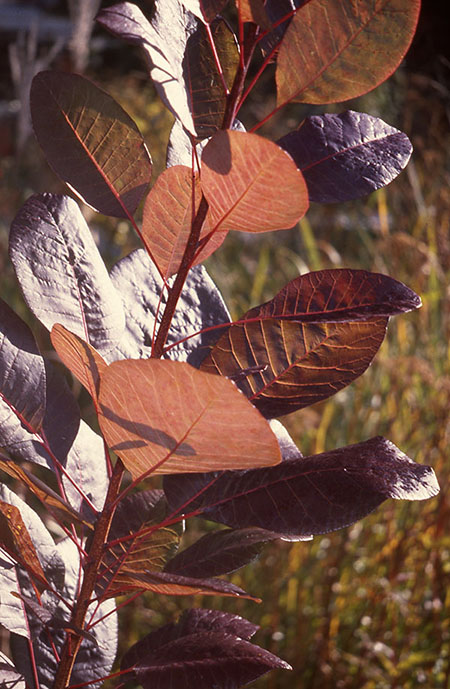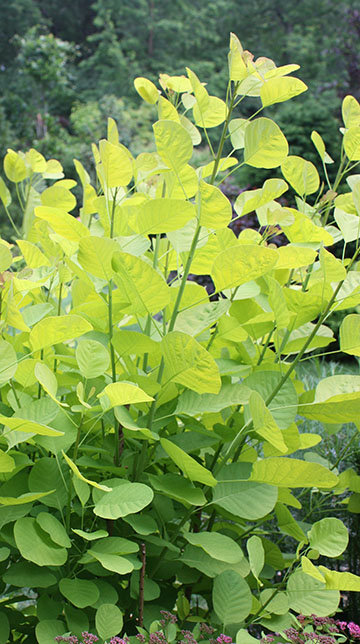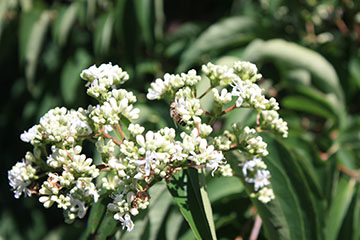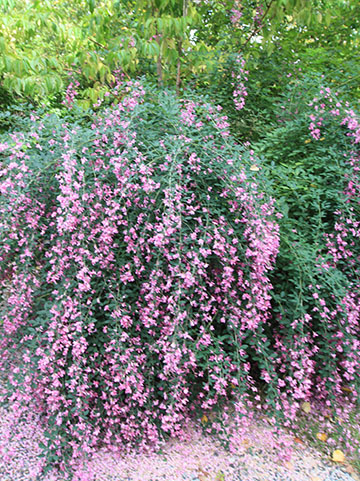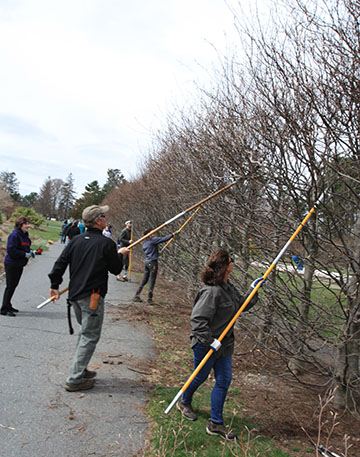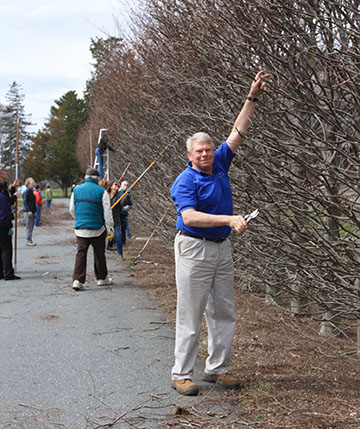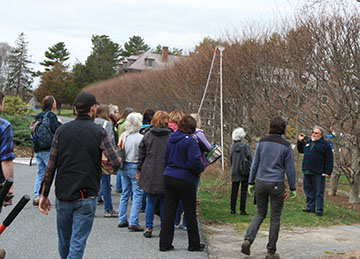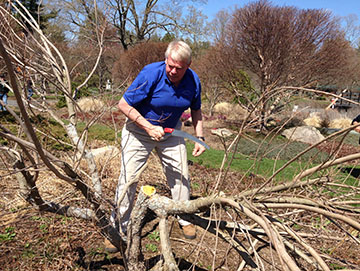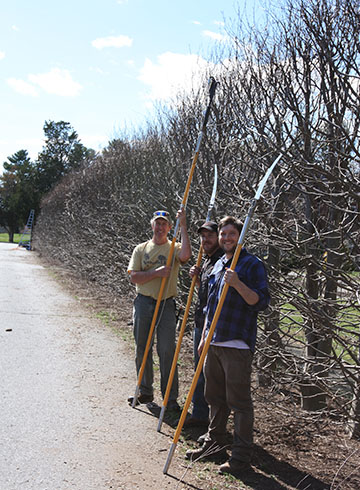Spring 2017 Newsletter
GARDENING In Containers
Growing plants in containers creates the opportunity for developing exciting ornamental relationships between the plants, the pot and the garden. Container gardening also allows the gardener to grow plants in locations where there is no soil for traditional gardening or where environmental conditions, such as a sandy beach or the dense root zone beneath a tree might deter the growth of the plant.
Containers literally elevate their contents above the ground and put plants "on stage", where they can really show off their flowers and foliage. The container itself can be neutral in color or it can offer a colorful contrasts and complements. Try planting the silver-leafed Pulmonaria 'Majesty' in a deep-blue glazed jardiniere, and nestled it next to the chartreuse foliage of Hosta 'Gold Standard' for a striking focal point in the shade.
Weatherproof containers, planted with hardy perennials or woody shrubs, add year-round sculptural interest to the garden. There are many durable container materials to choose from: fiberglass, plastic, wood, lead, composite stone and stoneware pottery.
Large stoneware pottery, either glazed or unglazed, is a favorite of ours for furnishing the garden. Stoneware is a high-fired pottery in which the clay turns vitreous - to glass. Unlike soft earthenware, it doesn't absorb water. Stoneware pots will not break in winter if they are filled with a soil medium (with or without plants). Glazed stoneware containers add both sculptural form and a colorful spark to the bleak winter landscape.
Growing mediums for containers are usually best composed of artificial soils. Garden soils will compact and not provide the free water drainage that container plants need. Mixes can be made of a combination of peat moss, composted bark, sand and perlite. Commercially available mixes such as Pro Mix BX provide the right texture for water retention and drainage appropriate for most plants. However, these soil-less mixes must be supplemented with fertilizers. A combination of slow release (Osmocote) and a balanced liquid fertilizer (20-20-20) will promote good growth.
Durable containers can be planted seasonally with annuals or permanently with shrubs, trees or perennials. However, since container culture exposes the plant's root zone to a much colder winter temperatures than plants in the ground, some plants that are hardy when planted in the ground may not be root hardy in a container. Yet many evergreen shrubs, dwarf conifers, grasses and herbaceous perennials will survive these low winter temperatures above ground.
Attractive and hardy container specimens can be found among the many cultivars in the evergreen plant families of Pine (Pinus), Arborvitae (Thuja), Yew (Taxus), Falsecypress (Chamaecyparis), Juniper (Juniperus) and Spruce ( Picea). Dwarf Alberta Spruce (Picea glauca 'Conica'), Mugo Pine (Pinus mugo mugo) and Rheingold Arborvitae (Thuja occidentalis 'Rheinhold') will grow for many years in a 24-inch diameter pot. Yews and falsecypress offer excellent shade tolerant container solutions.
The fragrantly foliaged Bayberry (Myrica pensylvanica) is as sturdy in a container as it is sprawling in rocky cracks in ledges along the ocean. Bayberry's tolerance to drought and ability to fix its own nitrogen are ideal characteristics for container culture. Bayberry grows with nearly complete neglect in a container in the shade of a Norway Maple by our garden shed. Ninebark (Physocarpus) is another very tough native shrub with attractive foliage for containers in sun or shade. Several ornamental grasses have proven to be root hardy for perennial container plantings.
Blue Oat Grass (Helictotrichon), Variegated Moor Grass (Molinia) and Feather-Reed Grass (Calamagrostis) are sun lovers. Blue Oat Grass (Helictotrichon sempervirens) combined with Dwarf Baby's Breath (Gypsophila repens), creeping over the edge is attractive for its blue foliage that also gives winter structure and interest. The beautiful chartreuse foliage of Variegated Moor Grass (Molinia caerulea 'Variegata') provides an accent in a container set on the edge of a mixed perennial border. The yellow foliage echoes golden daylilies and coreopsis. Molinia has proven hardy at the nursery (Zone 5) even in a shallow 18-inch diameter stoneware pan.
Cotinus coggygria 'Purpureus' offers a red foliage accent for full sun. Cotinus is a member of the same plant family as cut-leaf staghorn sumac, Rhus typhina 'Laciniata'. Both have hardy constitutions for container planting. Containers can be used to offer a good-looking solution to restrain the spreading habits of some plants. Blue Dune Grass (Elymus glaucus) is quick to spread by stolons. An old gardening trick is to plant it in a pot sunk in the ground. Thus tamed, its powder blue leaves provide a fabulous accent without overrunning the border. Try potting it up.
Warren P. Leach
Container Candidates
Ornamental Grasses |
Perennials |
Woody Shrubs and Trees |
Evergreen Shrubs |
| Helictotrichon sempervirens 'Sapphire' | Coreopsis verticillata | Aralia spinosa | Chamaecyparis obtusa gracilisi |
| Calamagrostis x acutiflora 'Overdam' | Geranium macrorrhizum | Cornus stolonifera 'Silver & Gold' | Juniperus varieties |
| Hakonechloa macra | Gypsophila repens | Cotinus coggygria 'Purpureus' | Picea abies 'Little Gem' |
| Hakonechloa macra 'Aureola' | Hemerocallis |
Malus cultivars | Pinus mugo |
| Molinia caerulea 'Variegata' | Hosta | Myrica pensylvanica | Taxus cuspidata |
| Panicum virgatum 'Heavy Metal' | Iris sibirica | Physocarpus opulifolius 'Luteus' | Thuja occidentalis 'Rheingold' |
| Pennisetum alopecuroides 'Hameln' | Pulmonaria | Rhus typhinia 'Laciniata' | |
| Sedum spectabile | Spiraea bumalda 'Gold Flame' | ||
| Sedum 'Matrona' | Spiraea japonica 'Goldmound' | ||
| Yucca filamentosa 'Bright Edge' | Spiraea thunbergii 'Ogon' | ||
| Ulmus parviflora 'Seiju' |
Composing in Primary Colors
A primary colors is defined as a hue that contain no hint of any other color. The three fundamental primary colors are red, blue and yellow. A blending of two of these basic, disparate colors produces a secondary color, for example blue and yellow makes green. This secondary color is considered a complement to the remaining primary color. Therefore, green is the complement to red. In color theory, a complementary color increases the impact of its assigned primary color. There are, however, many ways to arrange colors in a garden. A triadic arrangement pairs primary colors. Red yellow and blue, creates primary pizazz!
The same eye grabbing characteristic that makes the combination of red and yellow ideal for a fast-food restaurant or gas station along a busy highway, also creates the dazzle in drifts of red salvias planted with yellow marigolds. Red and yellow is certainly bright and cheerful, and the pairing of two primary colors increases either's impact. Red and yellow can also be subtle and charming as found in wild columbine, Aquilegia canadensis. The key to harmony is combing the right ratio of red and yellow.
Insight into creating pleasing color combinations can come about though planning or serendipity. Last spring, I planted my favorite yellow-leaf spiraea, Spiraea thunbergii 'Ogon' not thinking about the perennials near by. One July morning I ran for my camera to record the smashing combination of red and yellow. The fine, chartreuse foliage of Spiraea 'Ogon' was a perfect foil for the dark, classic-red daylily ‘Ed Murray’
Red and yellow makes me smile. It evokes a child-like pleasure, that of an innocent young gardener planting red Salvia splendens and Tagetes erecta. Wiegelia florida 'Rubidor' is outrageously colorful, and also brings grins of amusement. Lipstick red, tubular flowers grace chartreuse yellow foliage in perfect color proportion.
Red and yellow color combinations are a natural for daylilies. Hybidizers have created wonderfully patterned, color combinations. Hemerocallis 'Alna Pride' is an absolutely unique, golden yellow with a striking mahogany red eye on the petals only. Add the small yellow flowers of Hemerocallis 'Three Seasons' and combine with the red flowers of Achillea 'Strawberry Seductions', and Lychnis chalcedonica 'Lipstick' against the dark maroon foliage of Rosa glauca and Heuchera 'Blackout' for an enticing red and yellow composition. A dash of blue, provided by blue oat grass, Helictotrichon sempervirens or catmint, Nepeta 'Six Hills Giant', tones down the heat and is a bridge to other color transitions (orange or purple).
An easy way to start creating your red and yellow border is with colored foliage of shrubs and perennials. The foliage color will be a constant as flowers change through the season. Remember ‘ratio’, and avoid equal proportions of red and yellow.
Red foliage needs full sun to develop its dark pigmentation, though yellow foliage will hold its color in shade. Yellow ninebark, Physocarpus opulifolius 'Luteus' will grow in either sun or shade. In sun, add the scarlet red daylily 'Chicago Apache' as an accent; in partial shade, red beebalm Monarda 'Jacob Cline'.
Try variations of the following colorful plant combinations in your mixed border. In April and early May spring bulbs and emerging new foliage offer bright colors. The bunch flowering tulip 'Georgette', has flowers that age from yellow with a few red streaks to mostly red. Georgette is striking emerging through a yellow mass of Spiraea 'Mini Gold' next to Heuchera. Euphorbia amygdaloides 'Purpurea' yellow bracts carry on into June. Achillea 'Moonshine', and golden marjoram, Origanum vulgare aureum, set ablaze the golden flowers of Geum chiloense 'Lady Strathedon'.
Hemerocalliss 'Open Hearth' is fittingly named. This flat, spider type flower is a flaming red and copper bitone with a ruby halo around a prominent yellow throat. The daylilies 'Chicago Apache' and 'August Flame' extend blazing scarlet red into August. The yellow foliage and blue flowers of Caryopteris 'Worcester Gold' are a beautiful late summer accompaniment. Add Coreopsis 'Moonbeam' for a nice effect.
Purple smoke bush, Cotinus coggygria 'Atropurpurea' can be kept in scale in the perennial garden with severe pruning. Cut back to the ground (coppice) in the early spring. Cotinus will grow to four or more feet in a season. Combine the purple smoke bush with red leaf rose, Rosa glauca, to create a shadowy red background for Patrinia scabiosifolia, bronze fennel and blue oat grass. Patrinia blooms in August with yellow, Queen-Anne's-Lace like umbels. The umbel itself is yellow, remaining colorful long after the clusters of yellow flowers have dropped. The foliage turns red in late September to set off the arching yellow sprays of goldenrods, such as Solidago 'Golden Fleece'.
Red and yellow can even spark up the bleak winter landscape. Combine the bright red wands of red twig dogwood, Cornus sericea, under planted with the evergreen, yellow Euonymus 'Emerald 'n Gold' for some holiday cheer. A mass planting of Yucca filamentosa 'Gold Sword' in front of red berried Ilex verticillata 'Sprite' works too. Plant yellow daffodils and maroon foliaged Lysimachia ciliata 'Atropurpurea' next to the Yucca to ignite the spring garden season.
The next time you are searching for a colorful garden accent, remember primary colors. Who's afraid of red and yellow.
Warren P. Leach
|
|
The chartreuse foliage of Spiraea thunbergii 'Ogon' punctuated by a magenta clematis 'Lyon de Ville'. |
Tranquil Lake Nursery daylily fields, a composition in red and yellow. |
|
|
|
|
Rhus 'Tiger Eyes' with silver foliage of Buddleia 'Argentea and the purple-leaf nine bark Physocarpus 'Diablo' |
Purple Columns draped by golden Japanese Maple Acer shirasawanum 'Aurea', with Sedum acre in foregreound and a gold bromeliad Aechmea blanchetiana |
|
|
|
|
Red Rosa 'Europeana' and the red flowers of Maltese Cross blend with the purple foliage of Eupatorium 'Chocolate', Ligularia 'Desdemona' and Euphorbia dulchis 'Chameleon' on a yellow ground. |
Helictotrichon sempervirens 'Sapphire' makes a great foil with yellow foliage. |
|
|
|
|
Japanese Hakone Grass (Hakenochloa) provides golden foliage for the shade. Here it is paired with a pot of annuals flowers in red. |
Parthenocissus 'Fenway Park' and Japanese Hakone Grass for a cool space in the shade. |
|
|
|
|
Paint can add color to the garden too. Here a lavender fence and yellow painted bamboo are set off by a red geranium. |
Cotinus coggygria 'Royal Purple' and the tropical bromelia Aechmea blanchetiana. |
|
|
Gardening for Butterflies
Butterfly gardening is easy and rewarding. The butterfly garden will provide enjoyment and educational opportunities such as observation, record-keeping, study of native butterflies and plants, and subjects for photography. You can also increase the prosperity of common butterflies whose wild habitats have been reduced or destroyed.
To attract butterflies to your garden, you must first provide the nectar plants that nourish adult butterflies. Once the butterflies have found your garden they are likely to stay and reproduce, as long as their other basic needs of water, sun, shelter and reproductive areas can also be met.
Nectar Plants: Although some butterfly species are attracted to a wide range of nectar sources, others express definite preferences in size, shape, or color of flowers. A wide variety of food plants will give the greatest diversity of visitors. Try staggering wild and cultivated plants, as well as blooming times of the day and year. Groups of the same plants will be easier for butterflies to see than singly planted flowers.
Butterflies can not hover very long and need a place to land. They prefer composites (daisy-like flowers), panicles (large clusters of blooms on a stem), and umbels (flat topped flowers that originate from a single apex). These plants provide a landing pad for the butterflies and easy access to the nectar.
When given the choice, butterflies prefer to visit stands of flowers with strong colors such as orange, yellow and purple. They view the environment through polarized light in the ultraviolet range. The UV light enables them to see hidden ultraviolet patterns on the petals which guide them to the heart of the nectar source. In addition to color and shape, the fragrance of the flowers is what really draws the butterflies to the garden. Flowers with the heaviest perfume are most appealing to the butterflies sensitive sense of smell. Highly hybridized and double flowers do not usually provide a good source of nectar.
Popular flowers with adult butterflies include shrubs such as honeysuckle, lilac, buddleia (butterfly bush), sweet pepperbush (clethra), rhododendron, and viburnum. Perennials that attract adult butterflies include: echinacea, (coneflower), stokesia (Stokes aster), scabiosa (pincushion flower), mint, liatris, asclepias (butterfly weed), daises of all kind, lilies, daylilies, coreopsis, phlox, monarda (beebalm), sedum, heliopsis, gaillardia, nepeta (catmint), alliums, lantana, sweet alyssum, candytuff, zinnias, lavender, fleabane, delphinium, asters, rudbeckia (black-eyed Susan), eupatorium (perennial ageratum), verbena and veronica. There are also many wildflowers that provide food sources for adults. These include milkweed, dandelion, clover, goldenrod, thistle, asters, eupatorium spp. (Joe-Pye weed, boneset), fleabane and yarrow. Some butterfly species may prefer to partake of manure piles, tree sap, carrion and rotting fruit.
Reproductive Areas: Having attracted adult butterflies to your garden, you can prolong their stay by encouraging them to mate and lay eggs. The larva and adult stages of butterflies will require different food sources. Female butterflies are much more selective of the plants on which they will lay eggs than they are of nectar plants. Only certain specific plants contain the chemical constituents needed to nurture their caterpillars and fuel the metamorphosis from caterpillar to adult butterfly.
Larval Host Plants: Providing the right host plant in your garden is the most important step in creating a butterfly garden. It is important to plant a large number of host plants in order to provide adequate food for the caterpillars. They will perish if there is not enough available. In addition to food, the host plants provide shelter for all stages of the butterflies life cycle.
Trees and shrubs such as aspen, dogwood, oak, elm, sassafras, cherry, hawthorn, poplar, blueberry, spicebush, viburnum and willow offer a good source of food for the larva. Plant globe thistle, hollyhocks, beans, cabbage family, lupines, pipevine, snapdragons, yarrow and members of the carrot family, such as parsley and dill. Wildflowers such as milkweed, butterfly weed, thistle, nettle, violet, plantain, asters, dock, clover, turtlehead, pearly everlasting, mustard, Queen Anne's lace, vetch, meadowsweet and grasses are also important larval sources.
When a caterpillar becomes fully grown, it pupates and begins its magical transformation, or metamorphosis, into an adult butterfly. When it emerges, days or even months later, you will want to have its favorite nectar food available.
Many species travel only a few hundred yards from where they hatch. In addition to planting flowers for butterflies, try to leave an unkempt area, such as a weed patch or meadow, to attract new species. This will provide food sources for both larva and adults.
Water: Like all living creatures, butterflies require water. Place small stones in birdbaths to give them a place to land and sip water, or add moist gravel in a driveway or sunken container. Some species enjoy mud puddles where they will “'puddle” individually or in groups.
Permanent puddles are easy to make by burying a bucket to the rim, filling it with gravel or sand, and pouring in liquids such as stale beer, sweet drinks or water. Overripe fruit, allowed to sit for a few days is a very attractive substance (to them!).
Sun: Al insects are cold-blooded and cannot internally regulate their body temperature. Butterflies will readily bask in the sun when it is warm out, but few are seen on cloudy days. It is a good idea to leave open areas in a yard for butterflies to sun themselves, as well as partly shady areas like trees or shrubs, so they can hide when it's cloudy or cool off if it is very hot.
Shelter: Provide shelter to protect butterflies from extremes in temperature, rain, storms, predators and locations for roosting. Shrubs, thickets, rock walls and wood piles provide shelter and hiding places. They also offer nooks and crannies for over-wintering caterpillars or adults.
Moths: To attract moths to the garden, night blooming varieties are necessary. The following are extremely fragrant and are readily available; night blooming jasmine, four o' clocks, and nicotiana. The best time to look for moths is right around dusk. Many of these flowers are white and reflect the disappearing sun and the emerging moonlight.
By cultivating the specific food plants of specific butterfly or moth species and providing propitious condition for egg laying, caterpillar survival, and metamorphosis, you can actually regulate what kinds and how many visit your garden. All you need to get started is a basic knowledge of butterfly and moth characteristics and behavior and a desire to learn the specific needs and habits of species which are common in your neighborhood,
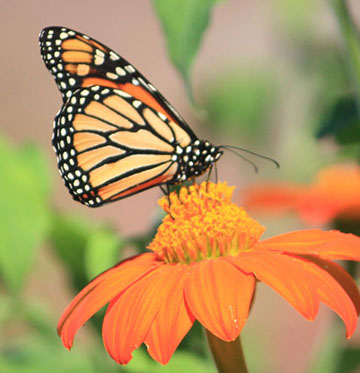 |
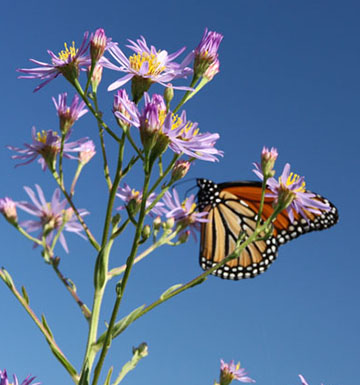 |
Monarch Butterfly on Tithonia (Mexican Sunflower). |
Monarch Butterfly on Aster tataricus in the fall. |
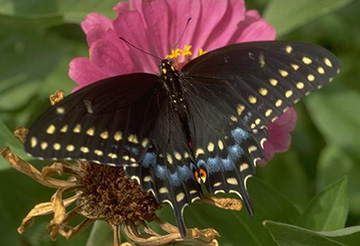 |
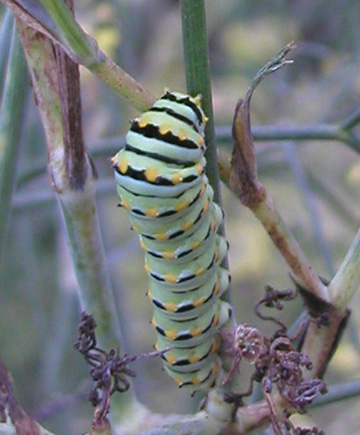 |
Black Swallowtail Butterfly on Zinnia. |
Black Swallowtail caterpillar on Dill. |
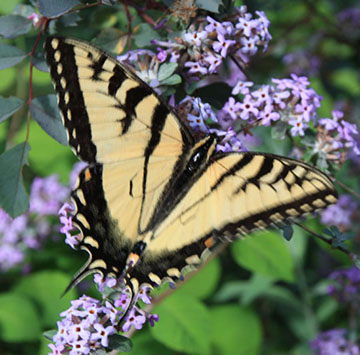 |
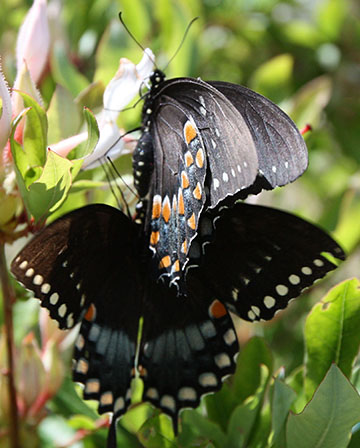 |
Eastern Tiger Swallowtail Butterfly on Buddleia alternifolia var. argentea (Silver Butterfly Bush). |
Spicebush Swallowtail Butterflies on azalea. |
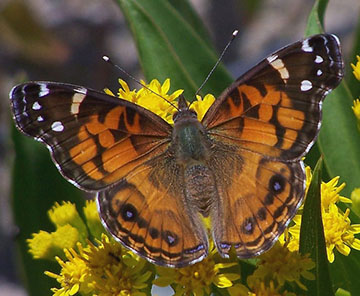 |
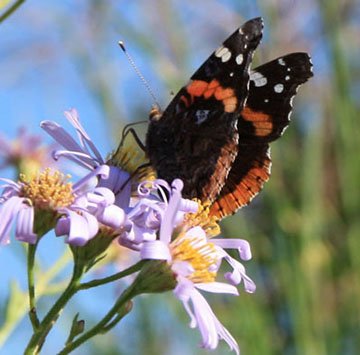 |
American Lady Butterfly on Hawkweed. |
American Lady Butterfly on Aster tataricus. |
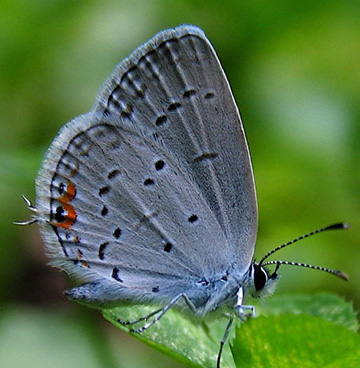 |
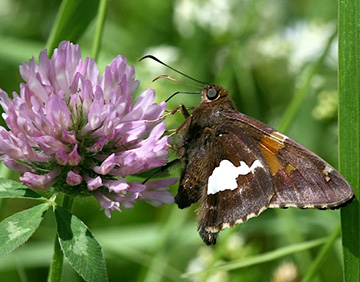 |
Eastern Tailed Blue Butterfly on Clover. |
Silver Spotted Skipper on Clover. |
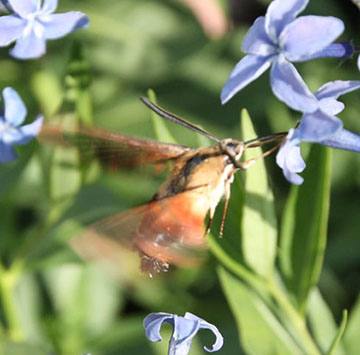 |
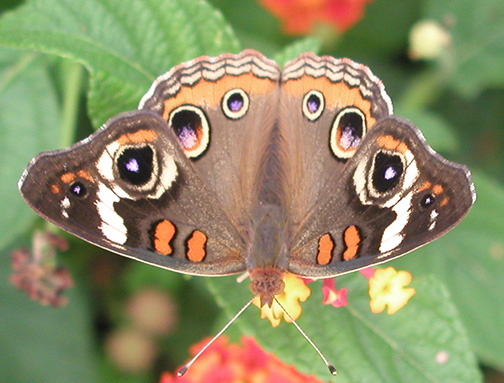 |
Hummingbird Clearwing Moth on Amsonia (Bluestar). |
Common Buckeye on Lantana.
|
Fragrant Gardens
"To make a great garden, one must have a great idea or a great opportunity; ... But it is possible to introduce a touch of imaginative beauty into almost any garden by finding the most perfect form for one of its features, or by giving expression to the soul of some particular flower ."
Sir George Sitwell examines the emotions of beauty in his book On the Making of Gardens, recently reprinted by Godine Press. This compilation of reflective wisdom, composed while exploring gardens in Italy nearly one hundred years ago, is still quire applicable to garden making today.
What quality expresses the "soul of a flower" more than its sweet scent? This ethereal quality of fragrance is an extra dimension beyond the tangible spatial constants within which we define our garden beds and borders. "Sweet scents are the swift vehicles of still sweeter thoughts, And nurse and mellow the dull memory, That would let drop without them her best stores." (Savage Landor)
The strongest stimulus to trigger a memory in a stream-of-consciousness style, is most likely that of a familiar scent. My own memories are indeed roused by smells. The scent of lilac (Syringa vulgaris), mock orange (Philadelphus coronarius), lemon lily (Hemerocallis lilio-asphodelus (H. flava), lily-of-the-valley (Convallaria majalis) and rugosa roses recall my most distant childhood memories of my mother’s garden. The lilacs were the common ones, familiar throughout rural Maine - often found memorialized an ancient foundation hole where a house once stood. I remember making a cave-like hideaway in the center of the lilac thicket of suckering stems and trunks. The sweetness of the lilac flowers are so intoxicating that they still induce me to spontaneously bury my nose in their flower heads and inhale deeply.
The mock orange bloomed after the lilacs, and the semi-double white flowers were even more fragrant than the lilac. I now recognize this exotic scent to be orange blossoms (Citrus). The neighbor’s had a fully double variety.
The lemon lily (Hemerocallis lilio-asphodelus) was my first encounter with the daylily. The lemon lily’s tall scapes of yellow flowers also smelled like orange blossoms. Hemerocallis 'Flavina' shares this delicious scent blooming Iris pallida in the nursery gardens in early June.. Lily-of- the-valley created a carpet at the north end of the house where asparagus also grew. The tall ferny asparagus foliage was ornamental and a nice addition to bouquets. Although, we cultivated extensive vegetable gardens, we didn’t eat asparagus. I discovered the taste of asparagus as an adult.
Fragrant and thorny roses grew as large spreading masses. A semi-double magenta-rose variety bloomed intermittently throughout the summer. The fragrance of rugosa roses transports me to the town of Castine on Penobscot Bay, where perfumed white rugosa roses grew.
Making a garden is a very personal expression. Select plants for your garden that have both fragrant flowers and fragrant foliage to enhance the experiences of everyone who comes near. Entry gardens are a logical location for fragrant plantings, whether sweet flowers or aromatic herbal foliage. Lilacs have been relegated by some horticultural authors to the second rate list, citing only one short season of attraction and foliage prone to mildew disfigurement. However, you don’t have to look long for confirmation of their popularity in New England gardens. This attests to the emotional pleasure that fragrant lilacs give us. We have to have lilacs, so select cultivars that have attractive mildew resistant foliage, like ‘Beauty of Moscow’ with huge fragrant white trusses with a hint of pink.
Syringa meyeri 'Palibin’ and Syringa patula ‘Miss Kim’ are dwarf varieties that can be kept in the four to six foot height range, bloom slightly later than common lilac and have attractive fall foliage color. ‘Palibin’ and Syringa patula ‘Miss Kim’ are dwarf varieties that can be kept in the four to six foot height range, bloom slightly later than common lilac and have attractive fall foliage color.
The Korean Spice Viburnum (Viburnum carlesii) welcomes Spring with early fragrant flowers and bids Autumn adieu with claret- red foliage. September blooming Heptacodium miconioides offers a precious fall flourish of fragrance.
If a rose isn’t fragrant, why bother. The sweet scented and single flowered native Rosa virginiana is not a perpetual bloomer, but has attractive hips and lustrous red fall foliage.
There are volumes of botanical references listing many sweet scented perennials, annuals, trees and shrubs. Part of the pleasure found in fragrance is its personal association. For instance, to me Astilbe ‘Peach Blossom’ smells like childhood memories of opening packets of grape Kool-aid!
Two disparate fragrant foliage plants, the tropical, citrus-scented lemon verbena (Aloysia triphylla) and the hardy, native, pungently aromatic sweet fern (Comptonia peregrina) are both scents reminiscent to me of the coast of Maine. Sweet fern and bayberry grow in poor dry cracks in rocks. Their scent, combined with the salt air, the fir and spruce forests are the essence of Mt. Desert Island. I remember a large, venerable lemon verbena growing in an stately Italian terra cotta pot at Thuja Gardens in Northeast Harbor. The lemon scent of the leaves was so intoxicating that you compulsively rubbed the leaves and smelled your fingers.
We can learn from George Sitwell’s account of absorbing the essence of gardens, discerning their design components and savoring the emotional experience to be translated in ones own garden. To make a great garden, one must have a great idea, a great opportunity, a measure of imagination and a keen nose.
Warren Leach
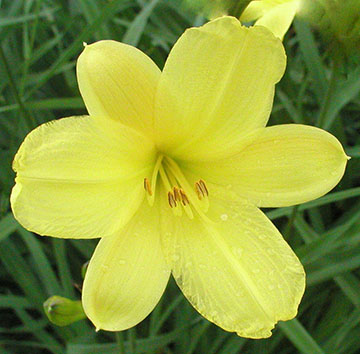 |
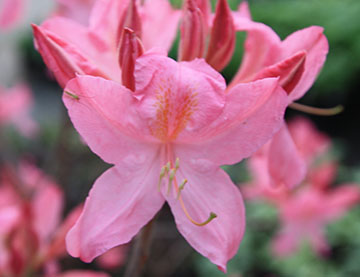 |
Hemerocallis 'Flavina', is one of the earliest daylilies to bloom for us, and very fragrant. |
Rhododendron 'Marie Hoffman' is an early blooming deciduous azalea, and extremely fragrant, with a clove-like scent. |
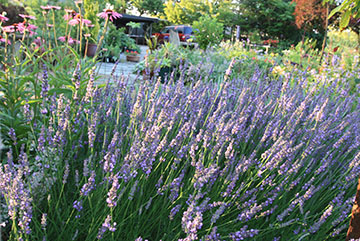 |
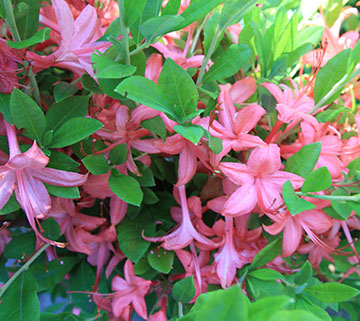 |
Lavandula 'Phenomenal' - A very fragrant lavender for summer bloom. |
Rhododendron 'Millenium' - This deciduous azalea blooms in July with spicy fragant flowers |
 |
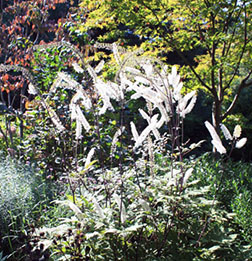 |
Peonies offer beauty and fragrance in June. |
Cimicifuga 'Brunette' - Bugbane is a shade loving perennial with tall wands of very fragrant flowers in late summer. |
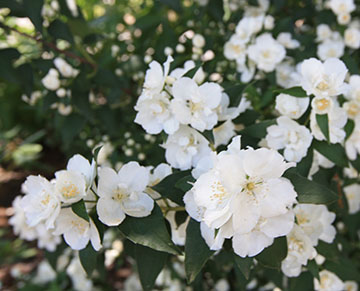 |
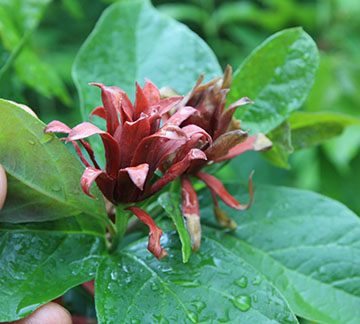 |
Philadelphus 'Janet Reidy' - a double flowering mock orange - smell like orange blossoms |
Calycanthus floridus - Carolina Allspice offers beauty and fragrance in June. |
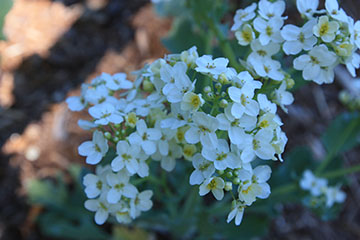 |
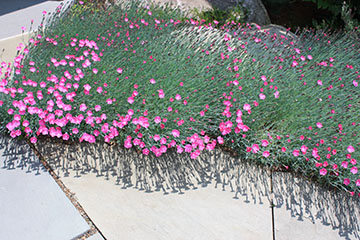 |
Crambe maritima - Sea Kale Flowers smell like honey. |
Dianthus 'Firewitch' - Cheddar Pinks Clove scented flowers. |
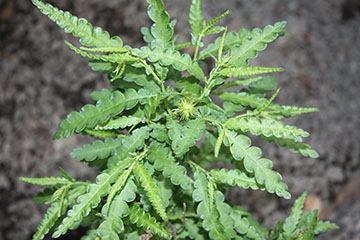 |
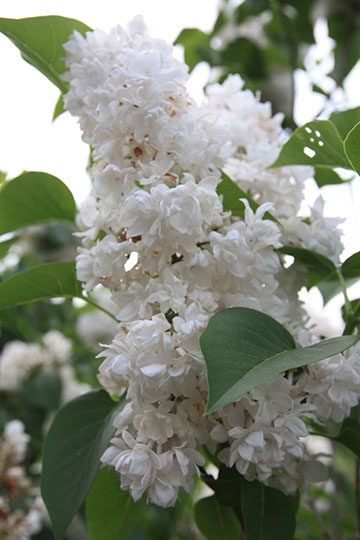 |
Comptonia peregrina - Sweetfern Fragrant foliage . |
Syringa 'Beauty of Moscow' - a very fragrant lilac.
|
Spring Pruning
Breaking leaf buds and emerging flowers are signatures of Spring’s awakening in the garden. They also signal to gardeners that it is time for spring pruning. Branches broken or damaged by winter storms should be pruned and removed as a matter of course. Plants that have died back, can be cut back to the first viable bud. There are even a few shrubs and trees that require spring pruning to promote masses of blooms in June or late summer. However, if flowers are what you desire, never spring prune a plant that blooms on last years woody growth.
The smooth hydrangea, Hydrangea arborescens ‘Annabelle’ should be cut to the ground to promote new growth that will be topped with billowy clouds of white flowers mid summer. Hydrangea paniculata cultivars also bloom on new growth. Spring pruning promotes large displays of flowers in July and August.
Blue hydrangeas, Hydrangea macrophylla, bloom on last years woody growth, which makes their flower buds prone to winter injury. If you spring prune, a blue hydrangea you will be removing this year's flower buds.
The fall blooming bush clover, Lespedezia thunbergii, also should be cut back to the ground. It will grow to five to six feet and become a cascade of lavender flowers in September. Heptacodium miconioides (Seven Son Flower) is a small tree that blooms on new wood in September. Prune Heptacodium in April and May to reduce its size as well as promote new growth that will be covered with fragrant white flowers in the fall.
Some shrubs respond to severe pruning with vigorous growth and larger leaves. The purple smokebush (Cotinus coggygria 'Royal Purple'), or any smokebush cultivar, is a perfect plant to coppice, cut back to the ground. It will respond by producing exceptionally large leaves and robust and more colorful growth. You won’t get any smoke though, they bloom on old wood! Prune red twig dogwood in late winter or spring to produce shorter and more brightly colored foliage.
Lilacs should be pruned and dead headed immediately after they bloom. However, if you want to rejuvenate an overgrown lilac, forget the flowers and prune in early spring to promote new growth. Cut back 1/3 of the total plant. Lilacs will set flower buds in late summer to bloom the following May.
The proverb “Many hands make light work”, very much described the pruning workshop 'Pleaching, Pollarding, Coppicing and Practices of Pruning' that was held at the Massachusetts Horticultural Society a week ago. Over 50 Massachusetts Master Gardeners participated at Elm Bank in Dover. Warren Leach presented a pruning workshop for the volunteers. Then Warren, and a team of expert pruning instructors took the Master Gardeners outside to pollard (cut back) the beech hedge in the Italianate Garden. These experts included Fred Perry, Director of Horticulture at Blithewold Mansion and Arboretum in Bristol, RI; Horticulturist Claude Benoit retired from Mt. Auburn Cemetery in Watertown, MA, MHS's John Forte and Tranquil Lake Nursery crew members Sam Mrozowski and Peter Lemieux. The beech hedge was divided into six sections about 15 to 20 feet long with a team 8 to 10 of volunteers and one expert assigned to each section. They worked together to make the decisions on where to prune and to make the actual cuts.
Whether the twiggy hornbeam or the beech,
The quick, the holly or the lime to pleach
Or little box, or gavity of yew
Cut into battlements to frame a view
He is both gardener and architect
Working in detail on his walls and piers
Of green anatomy, his garden’s frame
Design his object, shapeliness his aim,
Vita Sackville-West (1946)
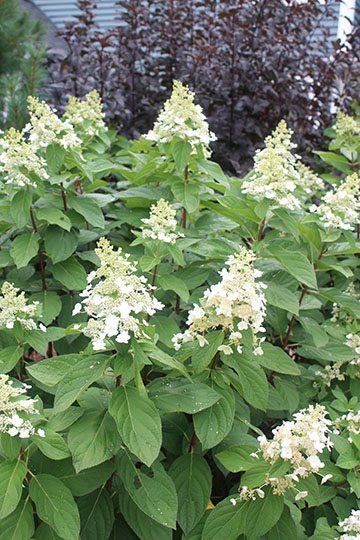 |
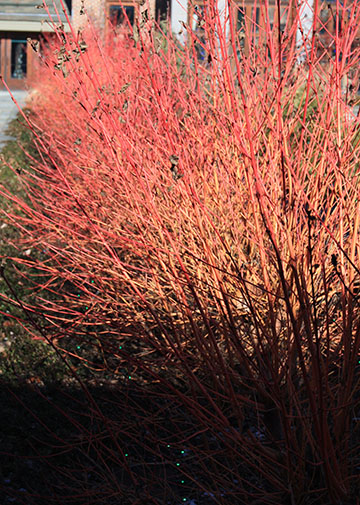 |
Hydrangea paniculata 'Tardiva' - cut back hard (1/2 to 2/3 the height) in spring. |
Cornus 'Midwinter Fire' - cut back 1/3 of plant to ground for colorful twigs the following winter. |
|
|
|
|
Caryopteris 'Longwood Blue' - cut back 1/3 in spring. |
Hydrangea arborescens 'Annabelle' - cut to the ground in spring. |
|
|
|
|
Prune seed heads off after flowering. To rejuvenate lilacs, forgo flowers and cut back 1/3 in early spring. |
Prune Indigofera ambylantha to six inches in early spring. |
|
|
|
|
Cotinus 'Grace' Coppice Smoke Bush to the ground in early spring for great foliage color, although no flowers. |
Cotinus 'Golden Spirit' can also be coppiced in spring. |
|
|
|
|
Heptacodium miconioides - prune in early spring to reduce size and promote September flowers. |
Lespedezia thunbergii - cut to the ground in spring for September bloom. |
|
|
|
|
Fred Perry and Master Gardeners, pollarding the Beech Hedge at Massachusetts Horticultural Society's Elm Bank. |
Warren Leach offered a pruning workshop at the Massachusetts Horticultural Society and guided volunteers on pollarding the Beech Hedge. |
|
|
|
|
The team of volunteer Master Gardener pruners at MHS's Elm Bank on April 13, 2017. |
Warren Leach coppicing to the ground a Cotinus (Smoke Bush) at MHS's Elm Bank. |
|
|
|
|
Fred Perry from Blithewold, Claude Benoit (not in photo) from Mount Auburn Cemetery, and Sam and Peter from the Tranquil Lake Nursery's landscape crew also guided Master Gardener volunteers to prune the beech hedge. |
|

